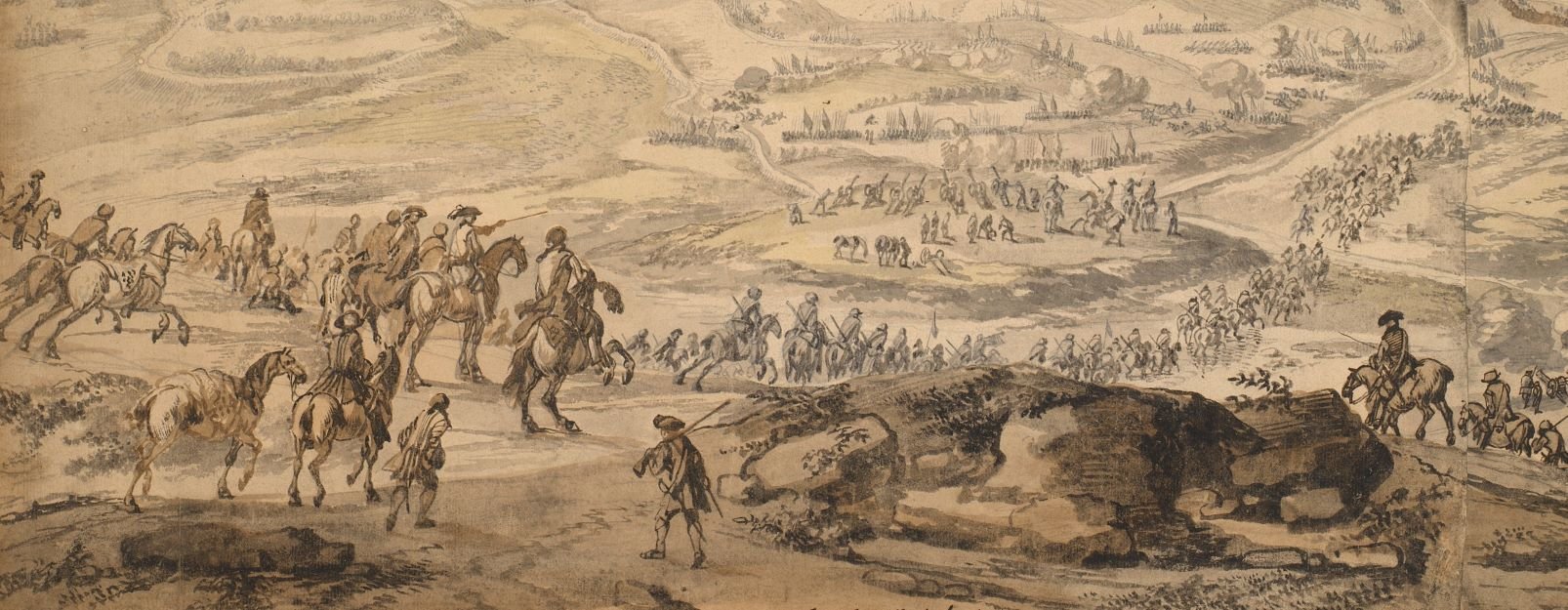
Printed and manuscript maps, prints and views of 22 seventeenth-century wars
Plan of Dundalk, 1689 (Dundalk, Leinster, Ireland) 54°00ʹ00ʺN 06°25ʹ00ʺW
1689 or laterPen, ink and watercolour on paper; laid down on coarse linen | Scale: 1:4,000 approx. | RCIN 724042
About half of Schomberg's army died from dysentery while in the camp. The men were encamped throughout in conditions of heavy rains, very cold nights, fog, drizzle and generally stormy weather. The camp is shown, sited on a dry tongue of land which is flanked by low-lying marshes; Dundalk itself is also surrounded by marsh. The long red lines in the town represent masonry walls. The destinations of the main roads are named: Newry, Draheda (Drogheda), County of Manahan (Monaghan), and Armagh. Cultivated land is indicated by parallel lines and brownish colouring and field divisions in the marshes are shown. There is no indication that any of the field outlines represent what was actually on the ground. An outline of field fortications is drawn in yellow to the north-west (right) of the retrenchments around the main camp. The colour yellow was a convention to indicate proposed works.
The tentative attribution to Gabriel Delahaye is based on the style of the elaborate compass rose, and the charming depiction of the figures of soldiers on horseback are strongly reminiscent of his later work, not just in the Royal Collection, but also in the collections at Boughton House and in the British Library. The lettering, however, is not so typical of his later polished products.
Additional text: [bottom right, in cartouche with a winged putto to each side, a key, A-I, L-Q, to the town, bridge, camps, artillery, battalions and regiments, guards, enemy scouts, trenches, etc.:] Explication
For further reading, see:
Padraig Lenihan, ‘Schomberg at Dundalk, 1689’, Journal of the County Louth Archaeological and Historical Society, vol.27, no.1, 2009, pp.39-52.
J.G. Simms, ‘Schomberg at Dundalk, 1689’, Irish Sword, vol.X, no.38, 1971, pp.17-19.
Condition: one fold line; seven stud holes to left and right edges; top right and bottom right corners cut off. Verso: surface dirt, the pattern of the surface dirt is consistent with the map having been tied in a roll.
? Gabriel Delahaye (active 1696-1723) (draughtsman)
Subject(s)
Army-GB-DragoonsArmy-GBWatermark: Double-headed eagle with crown and heart
Mark, stamped: 21
Condition: one fold line; seven stud holes to left and right edges; top right and bottom right corners cut off. Verso: surface dirt, the pattern of the surface dirt is consistent with the map having been tied in a roll
Scale: 1:4,000 approx. Scale bar: Eschelle de 500 Pas geometriques [109 mm =].
42.8 x 58.7 cm (neatline)
43.9 x 59.5 cm (image)
44.1 x 60.8 cm (sheet)
Manusctipt title:
CARTE DU / CAMP DE DUNDALK / Occupé par l’Armée de sa Majesté / Commandée par Mg.r le Duc de Schomberg / depuis le 7.e du mois de September jusques / de Nouembre / 1689 [top left, in elaborate cartouche, decorated with two lions symbolising the Williamite army]
Additional text:
[bottom right, in cartouche with a winged putto to each side, a key, A-I, L-Q, to the town, bridge, camps, artillery, battalions and regiments, guards, enemy scouts, trenches, etc.:] Explication
Annotations:
George III heading: Encampment at Dundalk 7 Sep. – Nov. 1689.
Other annotations: (Recto) none. (Verso) [top left, black pencil:] IV/65; [bottom right, black pencil:] IV/65; [bottom right, red pencil:] 3/129.
George III catalogue entry:
Dundalk Carte dessinée du Camp de Dundalk, occupé par l’Armée de S.M.B. commandée par le Duc de Schomberg depuis le 7 de Sept.re jusques au mois de Novembre 1689. [The same entry appears under the heading Encampment.]
Subject(s)
Dundalk, Leinster, Ireland (54°00ʹ00ʺN 06°25ʹ00ʺW)
Bibliographic reference(s)
P. Lenihan, ‘Schomberg at Dundalk, 1689’, Journal of the County Louth Archaeological and Historical Society, 27, no.1, 2009, pp. 39-52
J.G. Simms, ‘Schomberg at Dundalk, 1689’, Irish Sword, X, no.38, 1971, pp. 17-19
Page revisions
3 November 2024
Current version






